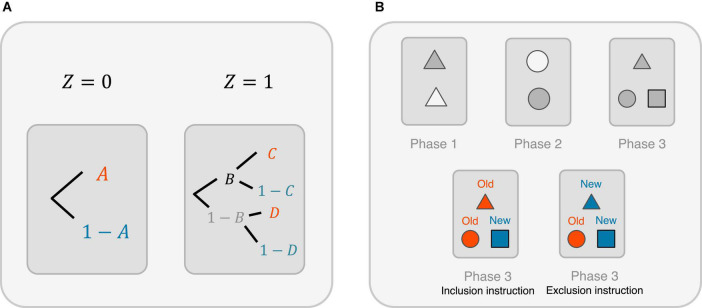FIGURE 3.
Linking the potential outcomes-based priming research with two prominent quantitative psychological methods. (A) Multinomial processing tree (MPT) model for studying the priming effect. Here, A and 1 − A are the probabilities of correctly and incorrectly, respectively, identifying the words without a word study (i.e., given Z = 0); B and 1 − B are the probabilities of storing (consciously or unconsciously) and not storing, respectively, the studied word after a word study (i.e., given Z = 1); C and 1 − C are the probabilities of correctly and incorrectly, respectively, identifying the words if the studied words are stored in the memory; D and 1 − D are the probabilities of correctly and incorrectly, respectively, identifying the words if the studied words are not stored in the memory. (B) A three-phase experiment with exclusion and inclusion instructional conditions. Top left: A set of items is shown during the Phase 1 study. Top middle: Another set of items (different from those in Phase 1) is shown during Phase 2. Top right: During Phase 3, the participants are given a list of items consisting of those who have appeared during Phases 1 and 2 and distractor items that have not appeared before. Subsequently, they are asked to classify them into either “old” or “new” following an inclusion instruction or an exclusion instruction. Bottom left: Under the inclusion instruction, participants need to call an item old if it has appeared in either Phase 1 or 2 and call a distractor item new. Bottom right: Under the exclusion instruction, participants need to call an item old only if it has appeared in Phase 2, and new otherwise.

